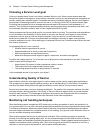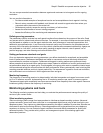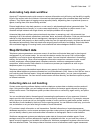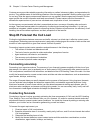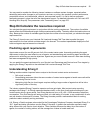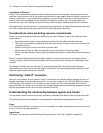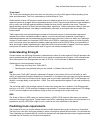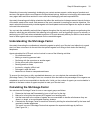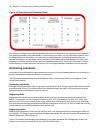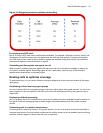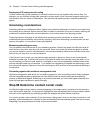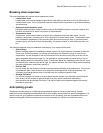
32 Chapter 3 Contact Center Planning and Management
Traffic calculators used to predict contact center resource requirements are available on the Web from
companies such as erlang.com. You can obtain basic calculators at no cost. Calculators that display and print
results or calculations made during the previous week are available at a modest cost.
To calculate the trunks required you simply input two of the figures and calculate the third. For example, if you
know that your Busy Hour Traffic is 10 erlangs and you want to determine how many trunks are required when
two calls are blocked in every 100 call attempts, you input the busy hour time (10) and your target rate of
blocking (0.02). The calculator displays a value for the trunks required (17).
Figure 3-3 illustrates the trunks required across a spectrum of GOS values. Whether you chose a GOS of
0.01, 0.05, or somewhere in between these values reflects how may calls per 100 call attempts you can afford
to lose. In revenue-based contact centers minimal blocking and delay is a priority.
Figure 3-3 Estimating the trunk requirement
Although some contact centers base the trunk requirement on a staff-to-trunk ratio, such as 1.5 trunks per
agent, many use the Erlang B equation. Whatever ratio results will be the right one for you.
It is better to slightly overestimate than slightly underestimate the number of trunks required: trunks are
inexpensive, compared to agent costs. You can always cancel a trunk if periodic Trunk Load calculations
show low occupancy on the trunk.
No staffing approach is absolute. You need to acknowledge the assumptions implicit in your calculations and
use common sense when estimating your resource requirements. When you schedule resources, they must
be closely monitored to ensure you are making full use of them.
Step #5 Schedule agents
Scheduling involves accurately forecasting the workload and determining which agents should work which
shifts. This has traditionally been a labor-intensive manual process for contact center supervisors. You can
schedule agents for breaks, split shifts, ACD and non-ACD work periods, repeating work patterns, holidays,
and on call work. You can categorize agents by pay level, overtime eligibility, skill level, employment status
(part time or full time), and scheduling preferences. Matching these shift and agent variables to the anticipated
workload, and re-allocating agents in response to employee absenteeism can be a daunting task.



